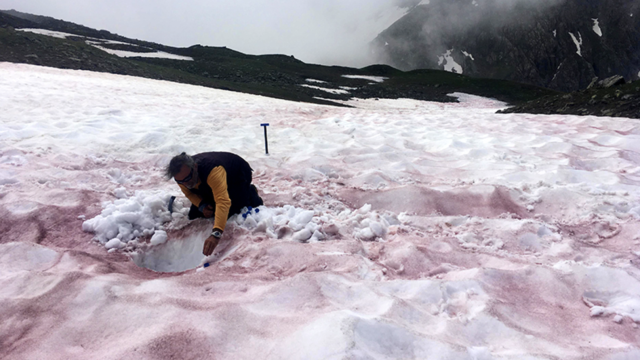Glaciers in the French Alps look like the scene of a massacre. Normally topped with pristine, white snow, they’re increasingly covered with dark, bloody-looking spots dubbed “glacier blood.”
The blotches aren’t actually blood — they’re microalgae blooms. It’s a phenomenon known as Chlamydomonas nivalis, wherein species of green algae that contain a red pigment undergo photosynthesis and stain the snow. But while the scenes may not show an actual murder, they do portend a dangerous future for ice in the Alps.
To learn more about these strange stains — and about what they can tell us about the climate crisis — a group of French scientists recently embarked on a project called AlpAlga. In a study published on Monday in Frontiers in Plant Science that details their results, the team described the algal blooms as “potential markers of climate change.”
Varieties that produce red, orange, or purple hues are found in mountain ranges all over the world, including not only the Alps but also the Rockies and even Greenland and Antarctica. As these snow-covered regions warm up amid the climate crisis, researchers have long suspected that more snowmelt is providing the ideal conditions for this algae to bloom, leading to an increase in pink snow.
The AlpAlga team wanted to see if that’s true, so in 2016, they set out on an expedition to collect soil samples from five sites in the French Alps at elevations ranging from 3,280 to 9,842 feet (1,000 to 3,000 meters) above sea level. The trek left them with 158 soil specimens, which they carefully studied.
Since soil is full of bits of DNA shed by all kinds of life, the soil samples allowed the scientists to create a clear picture of where dozens of different varieties of algae live. The researchers found that different species of algae thrive at different elevations.
For instance, the scientists found that an algae genus known as Sanguina, which produces a blood-red hue, has only been located at altitudes higher than 6,562 feet (2,000 meters). Two green microalgae varieties called Desmococcu and Symbiochloris, by contrast, only live at altitudes below 4,921 feet (1,500 meters).
The starkly separate distribution suggests that different kinds of algae are reliant on very particular thermal conditions to live. But as climate change heats up mountain ecosystems and shortens the snow season, it could mess with the organisms’ life cycles.
That’s bad news because like the microalgae that live in bodies of water, glacial algae is the base of the mountainous ecosystems’ food webs. As more snow gets covered in algae, it could also further destabilise the Alps’ remaining glaciers and snow patches because dark algae absorbs more of energy than bright, white snow. That could mean more warming for the region already facing a huge meltdown.
The new research is merely the beginning of the AlpAlga team’s attempts to figure out exactly what environmental conditions spark algal blooms, how changes in the climate and snowmelt affect its life cycles, and how these blooms are impacting remaining ice. The scientists plan to continue their work with an expedition into the Alps this month, examining how blooms change during different seasons. They hope this will teach them more about how these organisms — and the Alps as a whole — might change as the planet continues to warm.
One thing is clear, though: Climate change is already killing off ice in the region. The European Alps have already warmed by 2 degrees Celsius above pre-industrial temperatures, which is faster than the global average. Scientists have uncovered everything from World War I relics to a couple formerly entombed in ice. Research shows the mountains are on track to lose at least half their glaciers by midcentury, meaning an even more gruesome fate than blood snow could be in the Alps’ future unless we address carbon emissions soon.
